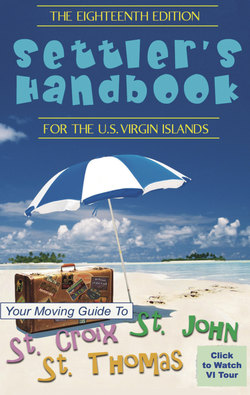Читать книгу VI Settler's Handbook - Mr. Cheyenne Harty - Страница 5
An Overview
ОглавлениеThe United States Virgin Islands, geologically formed of sedimentary rock and undersea lava flows, are located in the beautiful waters of the northern Caribbean, within the chain of all the Antilles, just west of the Atlantic Ocean. Surrounding the three Virgin Islands of St. Croix, St. John, St. Thomas—are 50 small, mostly uninhabited offshore islands and cays of which two are noteworty as the other two inhabited Virgins – Water Island and Hassell Island.
St. Croix, St. John and St. Thomas lie approximately 1,100 miles southeast of Miami and 1,650 miles south and east of New York City. Puerto Rico, a U.S. Commonwealth, is west and a little north about ninety miles away.The islands are in the Atlantic Time Zone, one hour ahead of New York and Florida,but on the same time during Daylight Savings Time. St. Croix’s latitude is a little over 17 degrees, while St. Thomas and St. John are at approximately 18 degrees. That means if you fly a direct path, east to west around the earth, you also fly over Mexico City, Hawaii and Bombay, India. The longitude at 64 degrees aligns with the Canadian province of Nova Scotia to the north, and the South American country of Venezuela to the south.
St. Croix, the southernmost island, is nearly forty miles south of St. Thomas and St. John. The “big island” is almost 84 square miles and has approximately two-thirds of the total land mass of the Virgins. It is almost twenty-four miles from end to end, with a width of just over five miles at its widest point. The highest point is Mount Eagle, which rises 1,165 feet above sea level. The two main towns are Christiansted, mid-island on the north shore, and Frederiksted, on the west end. Both retain their names from the Danish period on St. Croix. St. Croix sounds like St. Croy, and its residents refer to themselves as Crucians; pronounced Crew’-shuns. St. Croix, is the only one of the three Virgins completely surrounded by the Caribbean Sea; St. Thomas and St. John are bounded by the Atlantic on the north.
St. John, the smallest of these three, is nine miles long and four miles wide, about twenty square miles of land. The highest point is Bordeaux Mountain at 1,277 feet. Cruz Bay at its west end is the main town and population center, and Coral Bay at the island’s eastern end is a rapidly growing area. The island’s residents are called St. Joe’-ne’ans. About two-thirds of St. John is a natural preservation, bequeathed by Laurance Rockefeller. Notable sites include historic ruins of Annaberg Plantation, a natural campsite at Maho Bay Campground and the famous Trunk Bay beach.
St. Thomas, thirteen miles long and three miles wide, has a total area of just over thirty-one square miles. Crown Mountain, at 1,550 feet and near the center of the island, is the highest point. Charlotte Amalie (pronounced (A’-mal-yah), the territorial capital of the U.S. Virgin Islands, is also the largest population center on St. Thomas. Growing population areas include the Tutu (mid-isle), and Red Hook sections (east end). Residents are called St. To’-me-ans.
Water Island is just off the south coast of St. Thomas and has under 250 residents.
Hassel Island while inhabited by a dozen or so people is part of the National Park system.
